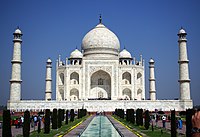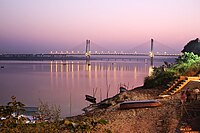Uttar Pradesh
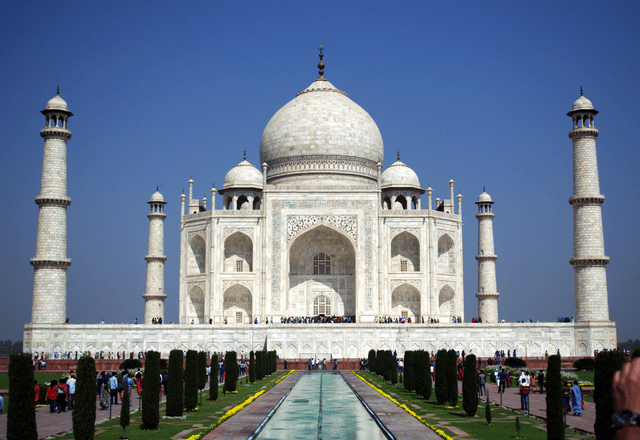
Uttar Pradesh

Uttar Pradesh | |||||||
|---|---|---|---|---|---|---|---|
State | |||||||
Clockwise from top: Taj Mahal, Agra Fort, Fatehpur Sikri, Sarnath, Manikarnika Ghat, New Yamuna Bridge | |||||||
| Etymology: Uttar (meaning 'north') and Pradesh (meaning 'province or territory') | |||||||
 Location of Uttar Pradesh in India | |||||||
 | |||||||
| Coordinates:26°51′N 80°55′E [277] | |||||||
| Country | |||||||
| Statehood | 24 January 1950[1] | ||||||
| Capital | Lucknow | ||||||
| Districts | ****75[2][3] | ||||||
| Government | |||||||
| • Type | Bicameral Legislative Council 100 Legislative Assembly 403 +1 Anglo Indian maybe Nominated by Governor Rajya Sabha 31 Lok Sabha 80 | ||||||
| • Body | Government of Uttar Pradesh | ||||||
| • Governor | Anandiben Patel[4][5] | ||||||
| • Chief Minister | Yogi Adityanath (BJP) | ||||||
| • Deputy Chief Ministers | Keshav Prasad Maurya (BJP) Dinesh Sharma (BJP) | ||||||
| • Chief Secretary | Anup Chandra Pandey, IAS[6][7][8] | ||||||
| • Director General of Police | O. P. Singh, IPS[9][10][11] | ||||||
| Area | |||||||
| • Total | 243,290 km2(93,930 sq mi) | ||||||
| Area rank | 4th | ||||||
| Population | |||||||
| • Total | 199,812,341 | ||||||
| • Rank | 1st | ||||||
| • Density | 820/km2(2,100/sq mi) | ||||||
| Demonym(s) | Uttar Pradeshi | ||||||
| GDP(2018–19) | |||||||
| • Total | ₹15.42 lakh crore(US$220 billion) | ||||||
| • Per capita | ₹61,351(US$890) | ||||||
| Languages[15] | |||||||
| • Official | Hindi | ||||||
| • Additional official | Urdu | ||||||
| Time zone | UTC+05:30 (IST) | ||||||
| UN/LOCODE | IN-UP | ||||||
| Vehicle registration | UP XX—XXXX | ||||||
| HDI(2017) | medium· 28th | ||||||
| Literacy(2011) | 67.68%[17] | ||||||
| Sex ratio(2011) | 912 ♀/1000 ♂[17] | ||||||
| Website | Official Website [278] | ||||||
| Timeline of reorganization & name changes of UP[46] | |||||||
| 1807 | Ceded and Conquered Provinces | ||||||
| 14 November 1834 | Presidency of Agra | ||||||
| 1 January 1836 | North-Western Provinces | ||||||
| 3 April 1858 | Oudh taken under British control, Delhi taken away from NWP and merged into Punjab | ||||||
| 1 April 1871 | Ajmer, Merwara & Kekri made separate commissioner-ship | ||||||
| 15 February 1877 | Oudh added to North-Western Provinces | ||||||
| 22 March 1902 | Renamed United Provinces of Agra and Oudh | ||||||
| 3 January 1921 | Renamed United Provinces of British India | ||||||
| 1 April 1937 | Renamed United Provinces | ||||||
| 1 April 1946 | Self rule granted | ||||||
| 15 August 1947 | Part of independent India | ||||||
| 24 January 1950 | Renamed Uttar Pradesh | ||||||
| 9 November 2000 | Uttaranchal state, now known as Uttarakhand, created from part of Uttar Pradesh | ||||||
| Million Plus Cities of Uttar Pradesh by population (2011 Census) | |||||||
| Name | Population | Name | Population | ||||
| Kanpur | 2,920,067 | Lucknow | 2,901,474 | ||||
| Ghaziabad | 2,358,525 | Agra | 1,746,467 | ||||
| Varanasi | 1,435,113 | Meerut | 1,424,908 | ||||
| Allahabad | 1,216,719 | Bareilly | 979,933 | ||||
| Population Growth | |||||||
| Census | Pop. | %± | |||||
| 1901 | 46,647,804 | — | |||||
| 1911 | 46,012,663 | −1.4% | |||||
| 1921 | 44,556,427 | −3.2% | |||||
| 1931 | 47,478,533 | 6.6% | |||||
| 1941 | 53,920,630 | 13.6% | |||||
| 1951 | 60,274,000 | 11.8% | |||||
| 1961 | 70,144,000 | 16.4% | |||||
| 1971 | 83,849,000 | 19.5% | |||||
| 1981 | 105,137,000 | 25.4% | |||||
| 1991 | 132,062,000 | 25.6% | |||||
| 2001 | 166,198,000 | 25.8% | |||||
| 2011 | 199,581,477 | 20.1% | |||||
| Source:Census of India | |||||||
Uttar Pradesh (/ˌʊtər prəˈdɛʃ/; IAST: Uttar Pradeś [ˈʊtːəɾ pɾəˈdeːʃ] (listen)) is a state in northern India. With roughly 200 million inhabitants, it is the most populous state in India as well as the most populous country subdivision in the world.[18] It was created on 1 April 1937 as the United Provinces of Agra and Oudh during British rule, and was renamed Uttar Pradesh in 1950. The state is divided into 18 divisions and 75 districts with the capital being Lucknow. The main ethnic group is the Hindavi people, forming the demographic plurality. On 9 November 2000, a new state, Uttarakhand, was carved out from the state's Himalayan hill region. The two major rivers of the state, the Ganga and Yamuna, join at Allahabad (Prayagraj) and then flow as the Ganga further east. Hindi is the most widely spoken language and is also the official language of the state.
The state is bordered by Rajasthan to the west, Haryana, Himachal Pradesh and Delhi to the northwest, Uttarakhand and Nepal to the north, Bihar to the east, Madhya Pradesh to the south, and touches the states of Jharkhand and Chhattisgarh to the southeast. It covers 243,290 square kilometres (93,933 sq mi), equal to 7.34% of the total area of India, and is the fourth-largest Indian state by area. Agriculture and service industries are the largest parts of the state's economy. The service sector comprises travel and tourism, hotel industry, real estate, insurance and financial consultancies. The economy of Uttar Pradesh is the third-largest state economy in India with ₹15.42 lakh crore (US$220 billion) in gross domestic product and a per capita GDP of ₹61,000 (US$880).[14] Uttar Pradesh ranks twenty eighth among Indian states in human development index.[16] President's rule has been imposed in Uttar Pradesh ten times since 1968, for different reasons and for a total of 1,700 days.[19]
The natives of the state are generally called UP-waale, or more specifically either Awadhi, Bageli, Bhojpuri, Braji, Bundeli, Kannauji, or Rohilkhandi depending upon their region of origin. Hinduism is practised by more than three-fourths of the population, with Islam being the next largest religious group. Uttar Pradesh was home to powerful empires of ancient and medieval India. The state has several historical, natural, and religious tourist destinations, such as Agra, Ayodhya, Vrindavan, Lucknow, Mathura, Varanasi, Allahabad and Gorakhpur.
Uttar Pradesh | |||||||
|---|---|---|---|---|---|---|---|
State | |||||||
Clockwise from top: Taj Mahal, Agra Fort, Fatehpur Sikri, Sarnath, Manikarnika Ghat, New Yamuna Bridge | |||||||
| Etymology: Uttar (meaning 'north') and Pradesh (meaning 'province or territory') | |||||||
 Location of Uttar Pradesh in India | |||||||
 | |||||||
| Coordinates:26°51′N 80°55′E [277] | |||||||
| Country | |||||||
| Statehood | 24 January 1950[1] | ||||||
| Capital | Lucknow | ||||||
| Districts | ****75[2][3] | ||||||
| Government | |||||||
| • Type | Bicameral Legislative Council 100 Legislative Assembly 403 +1 Anglo Indian maybe Nominated by Governor Rajya Sabha 31 Lok Sabha 80 | ||||||
| • Body | Government of Uttar Pradesh | ||||||
| • Governor | Anandiben Patel[4][5] | ||||||
| • Chief Minister | Yogi Adityanath (BJP) | ||||||
| • Deputy Chief Ministers | Keshav Prasad Maurya (BJP) Dinesh Sharma (BJP) | ||||||
| • Chief Secretary | Anup Chandra Pandey, IAS[6][7][8] | ||||||
| • Director General of Police | O. P. Singh, IPS[9][10][11] | ||||||
| Area | |||||||
| • Total | 243,290 km2(93,930 sq mi) | ||||||
| Area rank | 4th | ||||||
| Population | |||||||
| • Total | 199,812,341 | ||||||
| • Rank | 1st | ||||||
| • Density | 820/km2(2,100/sq mi) | ||||||
| Demonym(s) | Uttar Pradeshi | ||||||
| GDP(2018–19) | |||||||
| • Total | ₹15.42 lakh crore(US$220 billion) | ||||||
| • Per capita | ₹61,351(US$890) | ||||||
| Languages[15] | |||||||
| • Official | Hindi | ||||||
| • Additional official | Urdu | ||||||
| Time zone | UTC+05:30 (IST) | ||||||
| UN/LOCODE | IN-UP | ||||||
| Vehicle registration | UP XX—XXXX | ||||||
| HDI(2017) | medium· 28th | ||||||
| Literacy(2011) | 67.68%[17] | ||||||
| Sex ratio(2011) | 912 ♀/1000 ♂[17] | ||||||
| Website | Official Website [278] | ||||||
| Timeline of reorganization & name changes of UP[46] | |||||||
| 1807 | Ceded and Conquered Provinces | ||||||
| 14 November 1834 | Presidency of Agra | ||||||
| 1 January 1836 | North-Western Provinces | ||||||
| 3 April 1858 | Oudh taken under British control, Delhi taken away from NWP and merged into Punjab | ||||||
| 1 April 1871 | Ajmer, Merwara & Kekri made separate commissioner-ship | ||||||
| 15 February 1877 | Oudh added to North-Western Provinces | ||||||
| 22 March 1902 | Renamed United Provinces of Agra and Oudh | ||||||
| 3 January 1921 | Renamed United Provinces of British India | ||||||
| 1 April 1937 | Renamed United Provinces | ||||||
| 1 April 1946 | Self rule granted | ||||||
| 15 August 1947 | Part of independent India | ||||||
| 24 January 1950 | Renamed Uttar Pradesh | ||||||
| 9 November 2000 | Uttaranchal state, now known as Uttarakhand, created from part of Uttar Pradesh | ||||||
| Million Plus Cities of Uttar Pradesh by population (2011 Census) | |||||||
| Name | Population | Name | Population | ||||
| Kanpur | 2,920,067 | Lucknow | 2,901,474 | ||||
| Ghaziabad | 2,358,525 | Agra | 1,746,467 | ||||
| Varanasi | 1,435,113 | Meerut | 1,424,908 | ||||
| Allahabad | 1,216,719 | Bareilly | 979,933 | ||||
| Population Growth | |||||||
| Census | Pop. | %± | |||||
| 1901 | 46,647,804 | — | |||||
| 1911 | 46,012,663 | −1.4% | |||||
| 1921 | 44,556,427 | −3.2% | |||||
| 1931 | 47,478,533 | 6.6% | |||||
| 1941 | 53,920,630 | 13.6% | |||||
| 1951 | 60,274,000 | 11.8% | |||||
| 1961 | 70,144,000 | 16.4% | |||||
| 1971 | 83,849,000 | 19.5% | |||||
| 1981 | 105,137,000 | 25.4% | |||||
| 1991 | 132,062,000 | 25.6% | |||||
| 2001 | 166,198,000 | 25.8% | |||||
| 2011 | 199,581,477 | 20.1% | |||||
| Source:Census of India | |||||||
History
Prehistory
Modern human hunter-gatherers have been in Uttar Pradesh[20][21][22] since between around[23] 85,000 and 72,000 years ago. There have also been prehistorical finds in Uttar Pradesh from the Middle and Upper Paleolithic dated to 21,000–31,000 years old[24] and Mesolithic/Microlithic hunter-gatherer settlement, near Pratapgarh, from around 10550–9550 BC. Villages with domesticated cattle, sheep, and goats and evidence of agriculture began as early as 6000 BC, and gradually developed between c. 4000 and 1500 BC beginning with the Indus Valley Civilisation and Harappa Culture to the Vedic period and extending into the Iron Age.[25][26][27]
Ancient and classical period
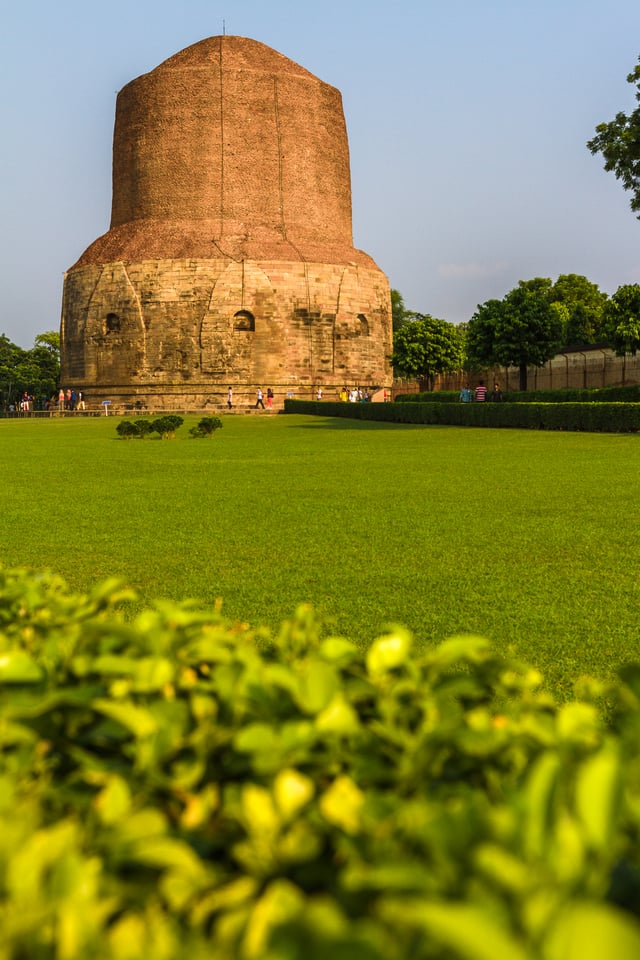
The Dhamekh Stupa in Sarnath is where Gautama Buddha first taught the Dharma, and where the Buddhist Sangha came into existence through the enlightenment of Kondanna.
The kingdom of Kosala, in the Mahajanapada era, was located within the regional boundaries of modern-day Uttar Pradesh.[28] According to Hindu legend, the divine king Rama of the Ramayana epic reigned in Ayodhya, the capital of Kosala.[29] Krishna, another divine king of Hindu legend, who plays a key role in the Mahabharata epic and is revered as the eighth reincarnation (Avatar) of the Hindu god Vishnu, is said to have been born in the city of Mathura, in Uttar Pradesh.[28] The aftermath of the Mahabharata yuddh is believed to have taken place in the area between the Upper Doab and Delhi, (in what was Kuru Mahajanapada), during the reign of the Pandava king Yudhishthira. The kingdom of the Kurus corresponds to the Black and Red Ware and Painted Gray Ware culture and the beginning of the Iron Age in northwest India, around 1000 BC.[28]
Control over Gangetic plains region was of vital importance to the power and stability of all of India's major empires, including the Maurya (320–200 BC), Kushan (AD 100–250), Gupta (350–600), and Gurjara-Pratihara (650–1036) empires.[30] Following the Huns' invasions that broke the Gupta empire, the Ganges-Yamuna Doab saw the rise of Kannauj.[31] During the reign of Harshavardhana (590–647), the Kannauj empire reached its zenith.[31] It spanned from Punjab in the north and Gujarat in the west to Bengal in the east and Odisha in the south.[28] It included parts of central India, north of the Narmada River and it encompassed the entire Indo-Gangetic plain.[32] Many communities in various parts of India claim descent from the migrants of Kannauj.[33] Soon after Harshavardhana's death, his empire disintegrated into many kingdoms, which were invaded and ruled by the Gurjara-Pratihara empire, which challenged Bengal's Pala Empire for control of the region.[32] Kannauj was several times invaded by the south Indian Rashtrakuta Dynasty, from the 8th century to the 10th century.[34][35] After fall of Pala empire, the Chero dynasty ruled from 12th century to 18th century.[36]
Delhi Sultanate
Parts or all of Uttar Pradesh were ruled by the Delhi Sultanate for 320 years (1206–1526). Five dynasties ruled over the Delhi Sultanate sequentially: the Mamluk dynasty (1206–90), the Khalji dynasty (1290–1320), the Tughlaq dynasty (1320–1414), the Sayyid dynasty (1414–51), and the Lodi dynasty (1451–1526).[37]
Medieval and early modern period
In the 16th century, Babur, a Timurid descendant of Timur and Genghis Khan from Fergana Valley (modern-day Uzbekistan), swept across the Khyber Pass and founded the Mughal Empire, covering India, along with modern-day Afghanistan, Pakistan and Bangladesh.[38] The Mughals were descended from Persianised Central Asian Turks (with significant Mongol admixture). In the Mughal era, Uttar Pradesh became the heartland of the empire.[33] Mughal emperors Babur and Humayun ruled from Delhi.[39][40] In 1540 an Afghan, Sher Shah Suri, took over the reins of Uttar Pradesh after defeating the Mughal king Humanyun.[41] Sher Shah and his son Islam Shah ruled Uttar Pradesh from their capital at Gwalior.[42] After the death of Islam Shah Suri, his prime minister Hemu became the de facto ruler of Uttar Pradesh, Bihar, Madhya Pradesh, and the western parts of Bengal. He was bestowed the title of Hemchandra Vikramaditya (title of Vikramāditya adopted from Vedic Period) at his formal coronation took place at Purana Quila in Delhi on 7 October 1556. A month later, Hemu died in the Second Battle of Panipat, and Uttar Pradesh came under Emperor Akbar's rule.[43] Akbar ruled from Agra and Fatehpur Sikri.[44] In the 18th century, after the fall of Mughal authority, the power vacuum was filled by the Maratha Empire, in the mid-18th century, the Maratha army invaded the Uttar Pradesh region, which resulted in Rohillas losing control of Rohilkhand to the Maratha forces led by Raghunath Rao and Malharao Holkar. The conflict between Rohillas and Marathas came to an end on 18 December 1788 with the arrest of Ghulam Qadir, the grandson of Najeeb-ud-Daula, who was defeated by the Maratha general Mahadaji Scindia. In 1803, following the Second Anglo-Maratha War, when the British East India Company defeated the Maratha Empire, much of the region came under British suzerainty.[45]
British India era
Starting from Bengal in the second half of the 18th century, a series of battles for north Indian lands finally gave the British East India Company accession over the state's territories.[47] Ajmer and Jaipur kingdoms were also included in this northern territory, which was named the "North-Western Provinces" (of Agra). Although UP later became the fifth-largest state of India, NWPA was one of the smallest states of the British Indian empire.[48] Its capital shifted twice between Agra and Allahabad.[49]
Due to dissatisfaction with British rule, a serious rebellion erupted in various parts of North India, which became known as the Indian Rebellion of 1857; Bengal regiment's sepoy stationed at Meerut cantonment, Mangal Pandey, is widely considered as its starting point.[50] After the revolt failed, the British divided the most rebellious regions by reorganising their administrative boundaries, splitting the Delhi region from 'NWFP of Agra' and merging it with Punjab, while the Ajmer- Marwar region was merged with Rajputana and Oudh was incorporated into the state. The new state was called the North Western Provinces of Agra and Oudh, which in 1902 was renamed as the United Provinces of Agra and Oudh.[51] It was commonly referred to as the United Provinces or its acronym UP.[52][53]
In 1920, the capital of the province was shifted from Allahabad to Lucknow. The high court continued to be at Allahabad, but a bench was established at Lucknow. Allahabad continues to be an important administrative base of today's Uttar Pradesh and has several administrative headquarters.[54] Uttar Pradesh continued to be central to Indian politics and was especially important in modern Indian history as a hotbed of the Indian independence movement. Uttar Pradesh hosted modern educational institutions such as the Benaras Hindu University, Aligarh Muslim University and the Darul Uloom Deoband. Nationally known figures such as Ram Prasad Bismil and Chandra Shekhar Azad were among the leaders of the movement in Uttar Pradesh, and Motilal Nehru, Jawaharlal Nehru, Madan Mohan Malaviya and Gobind Ballabh Pant were important national leaders of the Indian National Congress. The All India Kisan Sabha (AIKS) was formed at the Lucknow session of the Congress on 11 April 1936, with the famous nationalist Swami Sahajanand Saraswati elected as its first President,[55] in order to address the longstanding grievances of the peasantry and mobilise them against the zamindari landlords attacks on their occupancy rights, thus sparking the Farmers movements in India.[56] During the Quit India Movement of 1942, Ballia district overthrew the colonial authority and installed an independent administration under Chittu Pandey. Ballia became known as "Baghi Ballia" (Rebel Ballia) for this significant role in India's independence movement.[57]
Post-independence
After India's independence, the United Provinces were renamed "Uttar Pradesh" ("northern province"), preserving UP as the acronym,[58][59] notification regarding this was done in union gazette on 24 January 1950.[60] The state has provided nine of India's prime ministers, including current Prime Minister Narendra Modi who is MP from Varanasi, which is more than any other state and is the source of the largest number of seats in the Lok Sabha. Despite its political influence since ancient times, its poor record in economic development and administration, poor governance, organised crime and corruption have kept it amongst India's backward states. The state has been affected by repeated episodes of caste and communal violence.[61] In Ayodhya in December 1992 the disputed Babri Mosque was demolished by radical Hindu activists, leading to widespread violence across India.[62] In 2000, northern districts of the state were separated to form the state of Uttarakhand.[63]
Geography
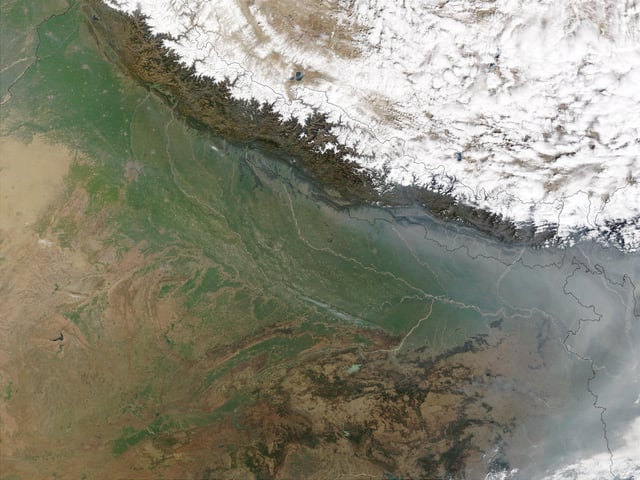
A part of the Gangetic Plain
Uttar Pradesh, with a total area of 243,290 square kilometres (93,935 sq mi), is India’s fourth-largest state in terms of land area and is roughly of same size as United Kingdom. It is situated on the northern spout of India and shares an international boundary with Nepal. The Himalayas border the state on the north,[64] but the plains that cover most of the state are distinctly different from those high mountains.[65] The larger Gangetic Plain region is in the north; it includes the Ganges-Yamuna Doab, the Ghaghra plains, the Ganges plains and the Terai.[66] The smaller Vindhya Range and plateau region is in the south.[67] It is characterised by hard rock strata and a varied topography of hills, plains, valleys and plateaus. The Bhabhar tract gives place to the terai area which is covered with tall elephant grass and thick forests interspersed with marshes and swamps.[68] The sluggish rivers of the bhabhar deepen in this area, their course running through a tangled mass of thick undergrowth. The terai runs parallel to the bhabhar in a thin strip. The entire alluvial plain is divided into three sub-regions.[68] The first in the eastern tract consisting of 14 districts which are subject to periodical floods and droughts and have been classified as scarcity areas. These districts have the highest density of population which gives the lowest per capita land. The other two regions, the central and the western are comparatively better with a well-developed irrigation system.[68] They suffer from waterlogging and large-scale user tracts.[68] In addition, the area is fairly arid. The state has more than 32 large and small rivers; of them, the Ganges, Yamuna, Saraswati, Sarayu, Betwa, and Ghaghara are larger and of religious importance in Hinduism.[69]
Cultivation is intensive.[70] The valley areas have fertile and rich soil. There is intensive cultivation on terraced hill slopes, but irrigation facilities are deficient.[71] The Siwalik Range which forms the southern foothills of the Himalayas, slopes down into a boulder bed called 'bhadhar'.[72] The transitional belt running along the entire length of the state is called the terai and bhabhar area. It has rich forests, cutting across it are innumerable streams which swell into raging torrents during the monsoon.[73]
Climate
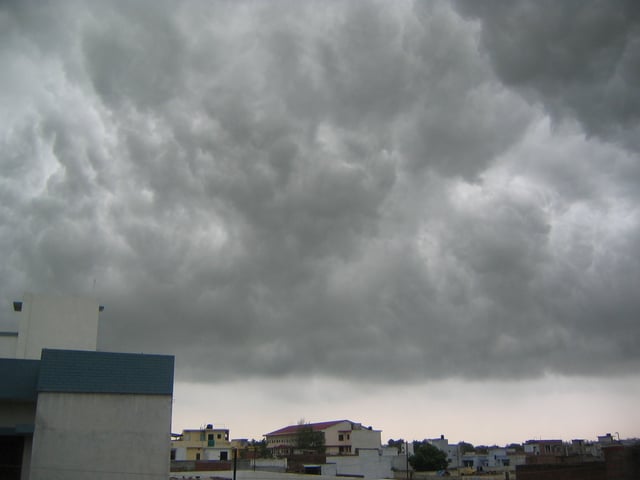
Monsoon clouds over Lucknow
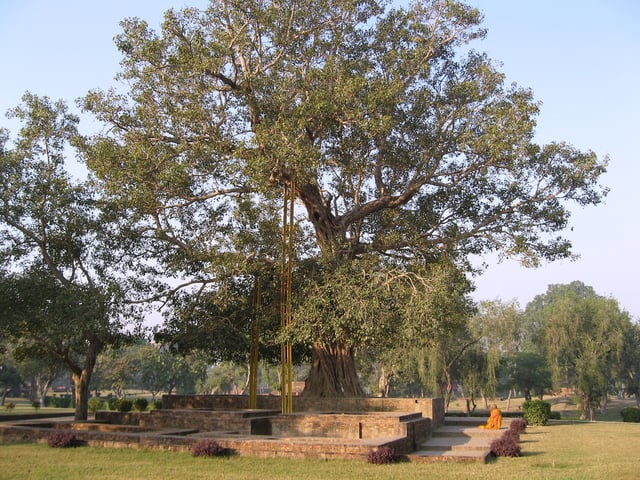
Anandabodhi tree in Jetavana Monastery, Sravasti
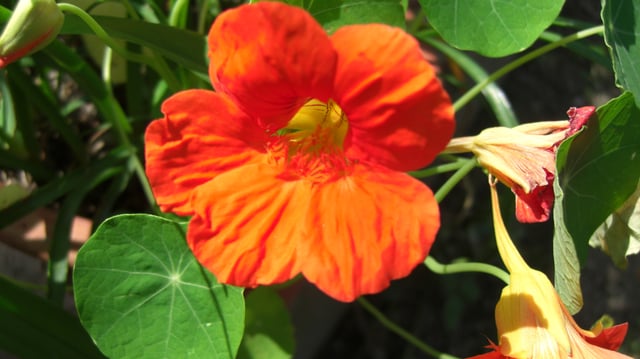
A hybrid nasturtium (Tropaeolum majus) showing nectar spur, found mainly in Hardoi district
Uttar Pradesh has a humid subtropical climate and experiences four seasons.[74] The winter in January and February is followed by summer between March and May and the monsoon season between June and September.[75] Summers are extreme with temperatures fluctuating anywhere between 0 °C and 50 °C in parts of the state coupled with dry hot winds called the Loo.[76] The Gangetic plain varies from semiarid to sub-humid.[75] The mean annual rainfall ranges from 650 mm in the southwest corner of the state to 1000 mm in the eastern and southeastern parts of the state.[77] Primarily a summer phenomenon, the Bay of Bengal branch of the Indian monsoon is the major bearer of rain in most parts of state. After summer it is the south-west monsoon which brings most of the rain here, while in winters rain due to the western disturbances and north-east monsoon also contribute small quantities towards the overall precipitation of the state.[74][78]
| Climate data for Uttar Pradesh | |||||||||||||
|---|---|---|---|---|---|---|---|---|---|---|---|---|---|
| Month | Jan | Feb | Mar | Apr | May | Jun | Jul | Aug | Sep | Oct | Nov | Dec | Year |
| Average high °C (°F) | 29.9 (85.8) | 31.9 (89.4) | 35.4 (95.7) | 37.7 (99.9) | 36.9 (98.4) | 31.7 (89.1) | 28.4 (83.1) | 27.4 (81.3) | 29.4 (84.9) | 31.4 (88.5) | 30.1 (86.2) | 28.9 (84.0) | 31.6 (88.9) |
| Average low °C (°F) | 11.0 (51.8) | 12.1 (53.8) | 15.8 (60.4) | 19.9 (67.8) | 22.4 (72.3) | 22.9 (73.2) | 22.2 (72.0) | 21.6 (70.9) | 20.8 (69.4) | 18.5 (65.3) | 14.4 (57.9) | 11.5 (52.7) | 17.8 (64.0) |
| Average precipitation mm (inches) | 0 (0) | 3 (0.1) | 2 (0.1) | 11 (0.4) | 40 (1.6) | 138 (5.4) | 163 (6.4) | 129 (5.1) | 155 (6.1) | 68 (2.7) | 28 (1.1) | 4 (0.2) | 741 (29.2) |
| Average precipitation days | 0.1 | 0.3 | 0.3 | 1.1 | 3.3 | 10.9 | 17.0 | 16.2 | 10.9 | 5.0 | 2.4 | 0.3 | 67.8 |
| Mean monthly sunshine hours | 291.4 | 282.8 | 300.7 | 303.0 | 316.2 | 186.0 | 120.9 | 111.6 | 177.0 | 248.44 | 270.0 | 288.3 | 2,896.34 |
| Source: [79] | |||||||||||||
| Average High and Low temperatures for various Uttar Pradesh Cities | ||||||||||||
| City | Jan | Feb | Mar | Apr | May | Jun | Jul | Aug | Sep | Oct | Nov | Dec |
| Lucknow[80] | 23/7 | 26/9 | 32/14 | 38/21 | 41/24 | 39/27 | 33/26 | 32/26 | 33/24 | 33/19 | 26/12 | 24/7 |
| Kanpur[81] | 33/22 | 33/22 | 33/24 | 34/26 | 33/26 | 29/23 | 29/23 | 29/22 | 31/26 | 31/23 | 32/23 | 32/22 |
| Ghaziabad[82] | 21/7 | 23/10 | 29/15 | 36/21 | 39/26 | 38/28 | 34/27 | 33/26 | 34/24 | 33/19 | 28/13 | 23/8 |
| Allahabad[83] | 23/8 | 27/11 | 33/17 | 39/23 | 42/27 | 40/28 | 34/26 | 33/26 | 33/25 | 33/21 | 30/14 | 25/9 |
| Agra[84] | 22/7 | 24/11 | 32/16 | 38/22 | 42/27 | 41/29 | 35/26 | 33/26 | 34/24 | 34/19 | 29/13 | 24/8 |
| Varanasi[85] | 23/8 | 27/11 | 33/16 | 39/22 | 41/27 | 39/28 | 33/26 | 33/26 | 33/25 | 32/21 | 29/14 | 24/9 |
| Gorakhpur[86] | 23/9 | 27/12 | 33/22 | 39/25 | 37/26 | 33/26 | 33/26 | 33/24 | 33/21 | 29/15 | 24/11 | 24/9 |
| Ayodhya | 23/15 | 27/12 | 33/11 | 32/25 | 37/26 | 33/26 | 33/26 | 33/24 | 33/21 | 29/15 | 24/11 | 23/9 |
| Bareilly[87] | 22/8 | 25/14 | 31/16 | 37/21 | 41/25 | 39/27 | 34/26 | 33/26 | 33/24 | 32/19 | 28/13 | 23/9 |
The rain in UP can vary from an annual average of 170 cm in hilly areas to 84 cm in Western U.P.[74] Given the concentration of most of this rainfall in the four months of the monsoon, excess rain can lead to floods and shortage to droughts. As such, these two phenomena, floods and droughts, commonly recur in the state. The climate of the Vindhya Range and plateau is subtropical with a mean annual rainfall between 1000 and 1200 mm, most of which comes during the monsoon.[75] Typical summer months are from March to June, with maximum temperatures ranging from 30 to 38 °C (86 to 100 °F). There is low relative humidity of around 20% and dust-laden winds blow throughout the season. In summers, hot winds called loo blow all across Uttar Pradesh.[74]
Flora and fauna
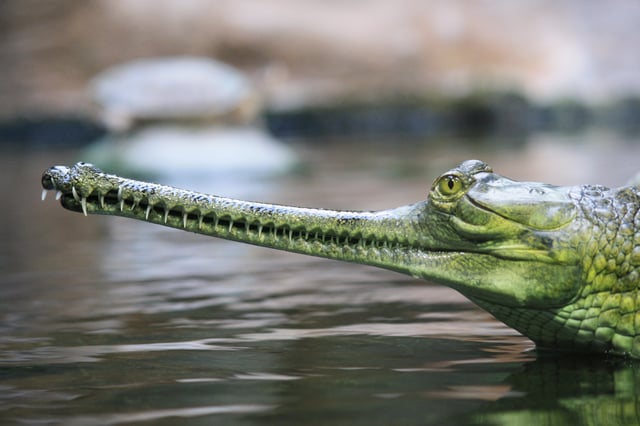
Gharial (Gavialis gangeticus) is found in the Ganges river
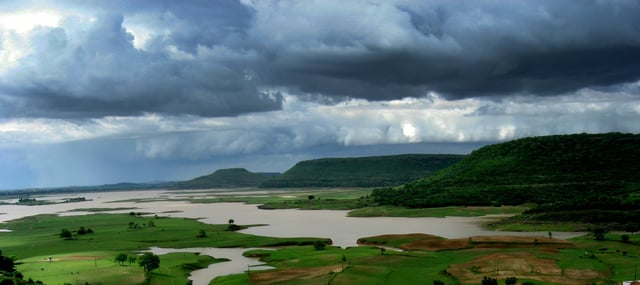
View of the Terai region
| State animal | Swamp deer | |
| State bird | Sarus crane |  |
| State tree | Ashoka | |
| State flower | Palash | |
| State dance | Kathak |  |
| State sport | Field hockey |
The state has an abundance of natural resources.[90] In 2011 the recorded forest area in the state was 16,583 km2 (6,403 sq mi) which is about 6.88% of the state's geographical area.[91] In spite of rapid deforestation and poaching of wildlife, a diverse flora and fauna continue to exist in the state. Several species of trees, large and small mammals, reptiles, and insects are found in the belt of temperate upper mountainous forests. Medicinal plants are found in the wild[92] and are also grown in plantations. The Terai-Duar savanna and grasslands support cattle. Moist deciduous trees grow in the upper Gangetic plain, especially along its riverbanks. This plain supports a wide variety of plants and animals. The Ganges and its tributaries are the habitat of large and small reptiles, amphibians, fresh-water fish, and crabs. Scrubland trees such as the babool and animals such as the chinkara are found in the arid Vindhyas.[93][94]
Tropical dry deciduous forests are found in all parts of the plains. Since much sunlight reaches the ground, shrubs and grasses are also abundant.[95] Large tracts of these forests have been cleared for cultivation. Tropical thorny forests, consisting of widely scattered thorny trees, mainly babool are mostly found in the southwestern parts of the state.[96] These forests are confined to areas which have low annual rainfall (50–70 cm), a mean annual temperature of 25–27 °C and low humidity.
Uttar Pradesh is known for its extensive avifauna.[97] The most common birds which are found in the state are doves, peafowl, junglefowl, black partridges, house sparrows, songbirds, blue jays, parakeets, quails, bulbuls, comb ducks, kingfishers, woodpeckers, snipes, and parrots. Bird sanctuaries in the state include Bakhira Sanctuary, National Chambal Sanctuary, Chandra Prabha Sanctuary, Hastinapur Sanctuary, Kaimoor Sanctuary, and Okhla Sanctuary.[98][99][100][101][102][103][104]
Other animals in the state include reptiles such as lizards, cobras, kraits, and gharials. Among the wide variety of fishes, the most common ones are mahaseer and trout. Some animal species in Uttar Pradesh have gone extinct in recent years, while others, like the lion from the Gangetic Plain and the rhinoceros from the Terai region, have become endangered.[105] Many species are vulnerable to poaching despite regulation by the government.[106]
On 9 August 2019, 220 million trees were planted in Uttar Pradesh. Planting was carried out in 1,430,381 places, including 60,000 villages and 83,000 sites in forest ranges.[107]
Divisions, districts and cities

Divisions of Uttar Pradesh
Uttar Pradesh is divided into 75 districts under these 18 divisions:[108]
The following is a list of top districts from state of Uttar Pradesh by population.[109]
Each district is governed by a District Magistrate, who is an Indian Administrative Service officer appointed Government of Uttar Pradesh and reports to Divisional Commissioner of the division in which his district falls.[110] The Divisional Commissioner is an IAS officer of high seniority. Each district is divided into subdivisions, governed by a sub-divisional magistrate, and again into Blocks. Blocks consists of panchayats (village councils) and town municipalities.[111] These blocks consists of urban units viz. census towns and rural units called gram panchayat.[110]
Uttar Pradesh has more metropolitan cities than any other state in India.[112][113] The absolute urban population of the state is 44.4 million, which constitutes 11.8% of the total urban population of India, the second-highest of any state.[114] According to the 2011 census, there are 15 urban agglomerations with a population greater than 500,000.[115] There are 14 Municipal Corporations,[116][117] while Noida and Greater Noida in Gautam Budh Nagar district are specially administered by statutory authorities under the Uttar Pradesh Industrial Development Act, 1976.[118][119]
In 2011, state's cabinet ministers headed by the then Chief Minister Mayawati announced the separation of Uttar Pradesh into four different states of Purvanchal, Bundelkhand, Avadh Pradesh and Paschim Pradesh with twenty-eight, seven, twenty-three and seventeen districts, respectively, later the proposal was turned down when Akhilesh Yadav lead Samajwadi Party came to power in the 2012 election.[120]
Demographics

Uttar Pradesh is largest subdivision(by population) in the world. Red area has smaller population than Uttar Pradesh (200 million)
Uttar Pradesh has a large population and a high population growth rate. From 1991 to 2001 its population increased by over 26%.[122] Uttar Pradesh is the most populous state in India, with 199,581,477 people on 1 March 2011.[123] The state contributes 16.16% of India's population. The population density is 828 people per square kilometre, making it one of the most densely populated states in the country.[13]
The sex ratio in 2011, at 912 women to 1000 men, was lower than the national figure of 943.[17] The state's 2001–2011 decennial growth rate (including Uttrakhand) was 20.09%, higher than the national rate of 17.64%.[124][125] Uttar Pradesh has a large number of people living below the poverty line.[126] Estimates released by the Planning Commission for the year 2009–10 revealed that Uttar Pradesh had 59 million people below the poverty line, the most for any state in India.[126][127]
As per 2011 census, Uttar Pradesh, the most populous state in India, is home to the highest numbers of both Hindus and Muslims.[128] By religion, the population in 2011 was Hindus 79.73%, Muslims 19.26%, Sikhs 0.32%, Christians 0.18%, Jains 0.11%, Buddhists 0.10%, and Others 0.30%.[129] The literacy rate of the state at the 2011 census was 67.7%, which was below the national average of 74%.[130][131] The literacy rate for men is 79% and for women 59%. In 2001 the literacy rate in Uttar Pradesh stood at 56.27% overall, 67% for men and 43% for women.[132]
Languages
Hindi is the official language of Uttar Pradesh and is spoken by the majority of the population (94.08%), although different regions have their own dialects.[15] These include Awadhi spoken in the Awadh region of eastern Uttar Pradesh, Bhojpuri spoken in the Bhojpuri region of eastern Uttar Pradesh, and Braj Bhasha spoken in the Braj region western Uttar Pradesh. Urdu is given the status of a second official language.[15]
Government and administration
The state is governed by a parliamentary system of representative democracy. Uttar Pradesh is one of the seven states in India, where the state legislature is bicameral, comprising two houses: the Vidhan Sabha (Legislative Assembly) and the Vidhan Parishad (Legislative Council).[134][135] The Legislative Assembly consists of 404 members who are elected for five-year terms. The Legislative Council is a permanent body of 100 members with one-third (33 members) retiring every two years. Since Uttar Pradesh sends the largest number of legislators to the national Parliament, it is often considered to be one of the most important states with respect to Indian politics.[136] The state contributes 80 seats to the lower house of the Indian Parliament, Lok Sabha and 31 seats to the upper house of the Indian Parliament, Rajya Sabha.[137][138][139][140]
Uttar Pradesh government is a democratically elected body in India with the Governor as its constitutional head and is appointed by the President of India for a five-year term.[141] The leader of the party or coalition with a majority in the Legislative Assembly is appointed as the Chief Minister by the Governor, and the Council of Ministers are appointed by the Governor on the advice of the Chief Minister. The governor remains a ceremonial head of the state, while the Chief Minister and his council are responsible for day-to-day government functions. The council of ministers consists of Cabinet Ministers and Ministers of State (MoS). The Secretariat headed by the Chief Secretary assists the council of ministers.[142][143] The Chief Secretary is also the administrative head of the government.[142][143] Each government department is headed by a Minister, who is assisted by an Additional Chief Secretary or a Principal Secretary, who usually is an officer of Indian Administrative Service, the Additional Chief Secretary/Principal Secretary serve as the administrative head of the department they are assigned to.[142][143] Each department also has officers of the rank of Secretary, Special Secretary, Joint Secretary etc. assisting the Minister and the Additional Chief Secretary/Principal Secretary.[142][143]
For purpose of administration, the state is divided into 18 divisions and 75 districts. Divisional Commissioner, an IAS officer is the head of administration on the divisional level.[142][144][145][146][147][148][149] The administration in each district is headed by a District Magistrate, who is an IAS officer and is assisted by a number of officers belonging to state services.[142][148][149][150][151][152][153]
The Uttar Pradesh Police is headed by an IPS officer of the rank of Director General of Police. There are 8 Police Zones, 18 Police Ranges and 75 police districts in the state. An IPS officer in the rank of Inspector General of Police heads the zones, whereas an IPS officer of the rank of Deputy Inspector General of Police heads the ranges. A Superintendent of Police, an IPS officer and assisted by the officers of the Uttar Pradesh Police Service, is entrusted with the responsibility of maintaining law and order and related issues in each district.
The judiciary in the state consists of the Allahabad High Court in Allahabad, the Lucknow Bench of Allahabad High Court, district courts and session courts in each district or Sessions Division, and lower courts at the tehsil level.[142][154] The President of India appoints the chief justice of the High Court of the Uttar Pradesh judiciary on the advice of the Chief Justice of the Supreme Court of India as well as the Governor of Uttar Pradesh.[68][142] Other judges are appointed by the President of India on the advice of the Chief Justice of the High Court.[142][154] Subordinate Judicial Service, categorized into two divisions viz. Uttar Pradesh civil judicial services and Uttar Pradesh higher judicial service is another vital part of the judiciary of Uttar Pradesh.[68][142] While the Uttar Pradesh civil judicial services comprise the Civil Judges (Junior Division)/Judicial Magistrates and civil judges (Senior Division)/Chief Judicial Magistrate, the Uttar Pradesh higher judicial service comprises civil and sessions judges.[142] The Subordinate judicial service (viz. The district court of Etawah and the district court of Kanpur Dehat) of the judiciary at Uttar Pradesh is controlled by the District Judge.[68][142][155]
Politics in Uttar Pradesh has been dominated by four political parties, the Samajwadi Party, the Bahujan Samaj Party, the Indian National Congress, and the Bharatiya Janata Party. Politicians from Uttar Pradesh have played prominent roles in Union Government of India with some of them having held the high positions of Prime Minister. Uttar Pradesh has been called India's under-achiever because it has provided India with eight prime ministers while remaining a poor state.[156]
Crime

Logo of Uttar Pradesh Police, the largest police force in the world[157]
According to the National Crime Records Bureau (2011 data), Uttar Pradesh has the highest number of crimes among any state in India, but due to its high population, the actual per capita crime rate is low.[158] Because of this, the NCRB states that UP is the third safest state in the country to live in. The value of human development index in Uttar Pradesh has steadily increased over time.[159][160] The Uttar Pradesh Police, governed by the Department of Home, is the largest police force in the world.[161][157][162]
Uttar Pradesh also reported the highest number of deaths—23,219—due to road and rail accidents in 2015, according to NCRB data. This included 8,109 deaths due to careless driving.[163]
Between 2006 and 2010, the state has been hit with three terrorist attacks, including explosions in a landmark holy place, a court and a temple. The 2006 Varanasi bombings were a series of bombings that occurred across the Hindu holy city of Varanasi on 7 March 2006. At least 28 people were killed and as many as 101 others were injured.[164][165]
In the afternoon of 23 November 2007, within a span of 25 minutes, six consecutive serial blasts occurred in the Lucknow, Varanasi, and Faizabad courts, in which 28 people were killed and several others injured.[166] The blasts came a week after the Uttar Pradesh police and central security agencies busted Jaish-e-Mohammed terrorists who had planned to abduct Rahul Gandhi. The Indian Mujahideen has claimed responsibility for these blasts in an email sent to TV stations five minutes before the blast.[167][168][169] Another blast occurred on 7 December 2010, the blast occurred at Sheetla Ghat in Varanasi in which more than 38 people were killed and several others injured.[170][171]
Economy
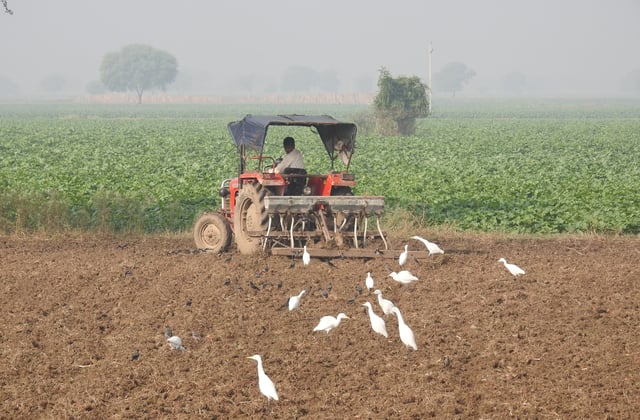
Located in the rich fertile Indo-Gangetic Plain, agriculture is the largest employment generator in the state.
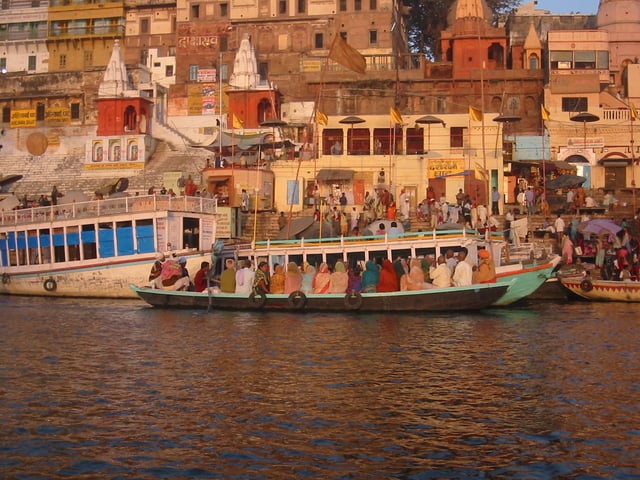
Varanasi's Dashashwamedh Ghat. Tourism is an important sector of the Uttar Pradesh economy. The holy cities of Varanasi, Mathura and Ayodhya attract pilgrims from all over the world.[179]
| **Net State Domestic Product at Factor Cost at Current Prices (2011–12 Base)**figures in crores of Indian Rupees | |
| Year | Net State Domestic Product[172] |
|---|---|
| 2011-12 | 229,074 |
| 2012–13 | 256,699 |
| 2013–14 | 294,031 |
| 2014–15 | 332,352 |
| 2015–16 | 384,718 |
| 2016–17 | 453,020 |
| 2017–18 | ₹1,446,000 crore(US$210 billion)[173](est.) |
In terms of net state domestic product (NSDP), Uttar Pradesh is the second-largest economy in India after Maharashtra, with an estimated gross state domestic product of ₹14.89 lakh crore (US$220 billion),[173] and hence contributes 8.406% of India. Agriculture is the leading occupation in Uttar Pradesh.[174] According to the report generated by India Brand Equity Foundation (IBEF), in 2014–15, Uttar Pradesh has accounted for 19% share in the country's total food grain output.[175] The state has experienced a high rate of economic growth in the past few years. Food grain production in the state in 2014–15 stood at 47,773.4 thousand tonnes. Wheat is the state's principal food crop and sugarcane is the main commercial crop particularly in Western Uttar Pradesh.[176] About 70% of India's sugar comes from Uttar Pradesh. Sugarcane is the most important cash crop as the state is country's largest producer of sugar.[175] As per the report generated by Indian Sugar Mills Association (ISMA), total sugarcane production in India was estimated to be 28.3 million tonnes in the fiscal ending September 2015 which includes 10.47 million tonnes from Maharashtra and 7.35 million tonnes from Uttar Pradesh[177]
State industries are localised in the Kanpur region, the fertile purvanchal lands and the Noida region. The Mughalsarai is home to a number of major locomotive plants. Major manufacturing products include engineering products, electronics, electrical equipment, cables, steel, leather, textiles, jewellery, frigates, automobiles, railway coaches, and wagons. Meerut is the sports capital of India and also a jewelry hub. More small-scale industrial units are situated in Uttar Pradesh than in any other state, with 12 percent of over 2.3 million units.[174] With 359 manufacturing clusters, cement is the top sector of SMEs in UP.[178]
The Uttar Pradesh Financial Corporation (UPFC) was established in the year 1954 under the SFCs Act of 1951 mainly to develop small- and medium-scale industries in the state.[180] The UPFC also provides working capital to existing units with a sound track record and to new units under a single window scheme.[181] As of July 2012, due to financial constraints and directions from the state government, lending activities have been suspended except for State Government Schemes.[182] The state has reported total private investment worth over Rs. 25,081 crores during the years of 2012 and 2016.[183] According to a recent report of World Bank on Ease of Doing Business in India, Uttar Pradesh was ranked among the top 10 states and first among Northern states.[184]
In 2009–10, the tertiary sector of the economy (service industries) was the largest contributor to the gross domestic product of the state, contributing 44.8% of the state domestic product compared to 44% from the primary sector (agriculture, forestry, and tourism) and 11.2% from the secondary sector (industrial and manufacturing).[185][186] MSME sector is the second-largest employment generator in Uttar Pradesh, the first being agriculture and employs over 92 lakh people across the state. Under the leadership of Akhilesh Yadav, Uttar Pradesh has exceeded 11 five-year plan targets and has established several Micro Small and Medium Enterprises (MSMEs) and generated 6.5 lakh employment opportunities across the state.[1] [279] During the 11th five-year plan (2007–2012), the average gross state domestic product (GSDP) growth rate was 7.28%, lower than 15.5%, the average for all states of the country.[187][188] The state's per capita GSDP was ₹29,417 (US$430), lower than the national per capita GSDP of ₹60,972 (US$880).[189] The state's total financial debt stood at ₹2,000 billion (US$29 billion) in 2011.[190] Labour efficiency is higher at an index of 26 than the national average of 25. The economy also benefits from the state's tourism industry.[191]
The state is attracting foreign direct investment which has mostly come in the software and electronics fields; Noida, Kanpur and Lucknow are becoming major hubs for the information technology (IT) industry and house the headquarters of most of the major corporate, media and financial institutions. Sonebhadra, a district in eastern Uttar Pradesh, has large-scale industries. Its southern region is known as the Energy Capital of India.[192] In May 2013 Uttar Pradesh had the largest number of mobile subscribers in the country, a total of 121.60 million mobile phone connections out of 861.66 million in India, according to the telecom regulator, Telecom Regulatory Authority of India (TRAI).[193][194][195][196]
Transportation
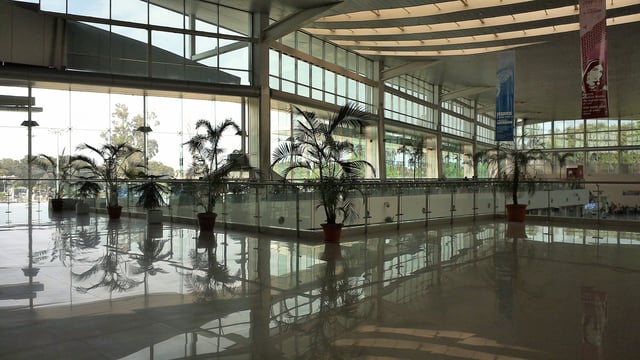
Inside view of the new airport terminal building
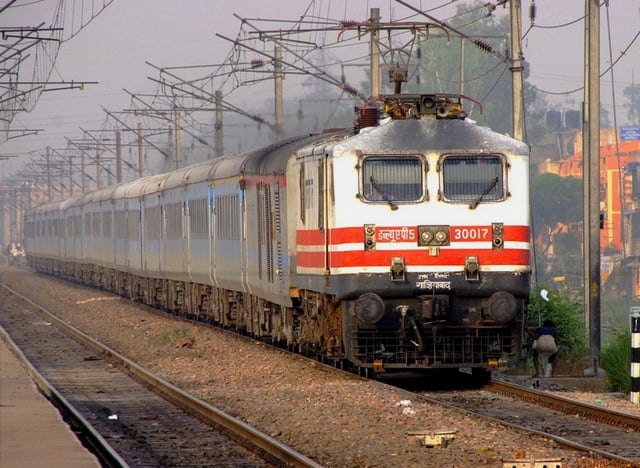
Lucknow Swarna Shatabdi Express near New Delhi.
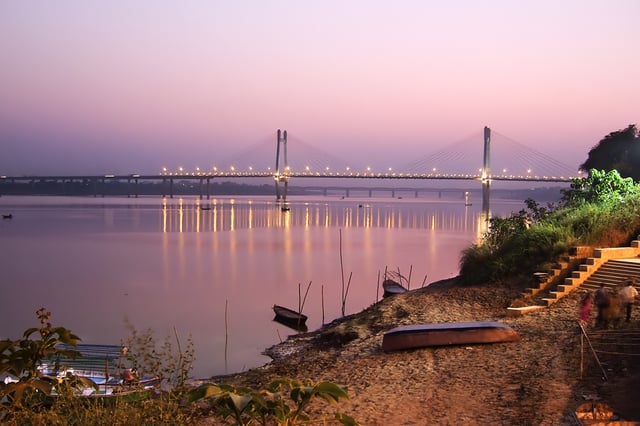
New Yamuna Bridge in Allahabad is part of National Highway 30
The state has the largest railway network in the country but in relative terms has only sixth-highest railway density despite its plain topography and largest population. As of 2011, there were 8,546 km (5,310 mi) of rail in the state.[197] Allahabad is the headquarters of the North Central Railway[198] and Gorakhpur is the headquarters of the North Eastern Railway.[199][200] Other than Zonal Headquarters of Allahabad and Gorakhpur, Lucknow and Moradabad serve as divisional Headquarters of the Northern Railway Division. Lucknow Swarna Shatabdi Express, the second fastest shatabdi train, connects the Indian capital of New Delhi to Lucknow. This was the first train in India to get the new German LHB coaches.[201] The railway stations of Lucknow NR, Kanpur Central, Varanasi Junction, Agra Cantt, Gorakhpur Junction, Mathura Junction included in the Indian Railways list of 50 world-class railway stations.[202]
The state has a large, multimodal transportation system with the largest road network in the country.[203] The state is well connected to its nine neighbouring states and almost all other parts of India through the national highways (NH). It boasts 42 national highways, with a total length of 4,942 km (9.6% of the total NH length in India). The Uttar Pradesh State Road Transport Corporation was established in 1972 to provide economical, reliable, and comfortable transportation in the state with connecting services to adjoining states[204] and boasts as being the only State Transport Corporation that runs in profit in the entire nation. All cities are connected to state highways, and all district headquarters are being connected with four lane roads which carry traffic between major centres within the state. One of them is Agra Lucknow Expressway, which is a 302 km (188 mi) controlled-access highway constructed by Uttar Pradesh Expressways Industrial Development Authority[205] (UPEIDA) to reduce vehicular traffic in previously congested roads. This expressway is country’s largest Greenfield Expressway which reduced the travel time between Lucknow and Agra from 6 hours to 3.30 hours.[206] Other district roads and village roads provide villages accessibility to meet their social needs as also the means to transport agriculture produce from village to nearby markets. Major district roads provide a secondary function of linking between main roads and rural roads.[207] Uttar Pradesh has the highest road density in India, (1,027 km per 1000 km2) and the largest surfaced urban-road network in the country (50,721 km).[208]
The state has two international airports located in Lucknow (Chaudhary Charan Singh International Airport) and Lal Bahadur Shastri International Airport in Varanasi.[209] and four domestic airports located at Agra, Allahabad, Gorakhpur and Kanpur. The Lucknow Airport is the second-busiest airport in North India after the Indira Gandhi International Airport, New Delhi. The state has also proposed creating the Taj International Airport at Kurikupa near Hirangaon, Tundla in Firozabad district.[210][211] Two more international airports have been proposed to be built at Kushinagar and Jewar, Greater Noida.[212][213] The Lucknow Metro has been operational since 9 March 2019 and Kanpur Metro is under construction. The capital cities are witnessing a swift rise in the number of immigrants and this has called for the transformation of public modes of transport.[214]
Sports
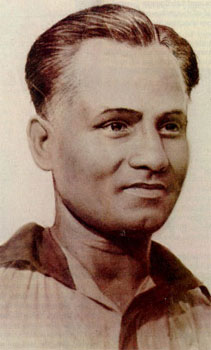
Indian hockey legend Major Dhyan Chand
Traditional sports, now played mostly as a pastime, include wrestling, swimming, kabaddi, and track-sports or water-sports played according to local traditional rules and without modern equipment. Some sports are designed to display martial skills such as using a sword or 'Pata' (stick).[215] Due to lack of organised patronage and requisite facilities, these sports survive mostly as individuals' hobbies or local competitive events. Among modern sports, field hockey is popular and Uttar Pradesh has produced some of the finest players in India, including Dhyan Chand and, more recently, Nitin Kumar[216] and Lalit Kumar Upadhyay.[217]
Recently, cricket has become more popular than field hockey. Uttar Pradesh won its first Ranji Trophy tournament in February 2006, beating Bengal in the final.[218] It can also boast of routinely having 3 or 4 players on the national side. Green Park Stadium in Kanpur, the only internationally recognised cricket stadium in the state, has witnessed some of India's most famous victories. Uttar Pradesh Cricket Association (UPCA) has headquarters in Kanpur. An International Cricket Stadium with a capacity of 50,000 spectators, is being set up in the capital city of Uttar Pradesh.
Greater Noida Cricket Stadium is another newly built international cricket stadium.[219]
The Buddh International Circuit hosted India’s inaugural F1 Grand Prix race on 30 October 2011.[220] The 5.14-kilometre-long (3.19-mile) circuit was designed by German architect and racetrack designer Herman Tilke to compete with other world-class race circuits.[221] However, races were only held three times before being cancelled due to falling attendance and lack of government support. The government of Uttar Pradesh considered Formula One to be entertainment and not a sport, and thus imposed taxes on the event and participants.[222]
Education

JRHU is the world's first school for handicap
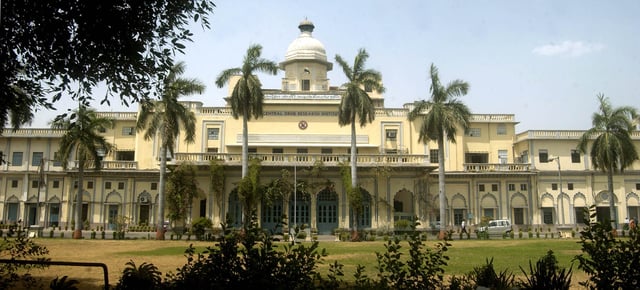
Central Drug Research Institute, an autonomous multidisciplinary research institute.
Uttar Pradesh has a long tradition of education, although historically it was primarily confined to the elite class and religious schools.[223] Sanskrit-based learning formed the major part of education from the Vedic to the Gupta periods. As cultures travelled through the region they brought their bodies of knowledge with them, adding Pali, Persian and Arabic scholarship to the community. These formed the core of Hindu-Buddhist-Muslim education until the rise of British colonialism. The present schools-to-university system of education owes its inception and development in the state (as in the rest of the country) to foreign Christian missionaries and the British colonial administration.[224] Schools in the state are either managed by the government or by private trusts. Hindi is used as a medium of instruction in most of the schools except those affiliated to the CBSE or the Council for ICSE boards.[225] Under the 10+2+3 plan, after completing secondary school, students typically enroll for two years in a junior college, also known as pre-university, or in schools with a higher secondary facility affiliated with the Uttar Pradesh Board of High School and Intermediate Education or a central board. Students choose from one of three streams, namely liberal arts, commerce, or science. Upon completing the required coursework, students may enroll in general or professional degree programs.
Uttar Pradesh has more than 45 universities,[226] including 5 central universities, 28 state universities, 8 deemed universities, 2 IITs in Varanasi and Kanpur, 1 IIM in Lucknow, 1 NIT in Allahabad, 2 IIITs, 1 National Law University in Lucknow and several polytechnics, engineering colleges and industrial training institutes.[227] Prestigious institutes like the Aligarh Muslim University, Sanjay Gandhi Postgraduate Institute of Medical Sciences, Indian Institute of Technology (Kanpur),[228] Indian Institute of Technology (BHU), the Indian Institute of Management (Lucknow), Motilal Nehru National Institute of Technology (Allahabad), Indian Institute of Information Technology (Allahabad), Indian Institute of Information Technology (Lucknow), University Institute of Engineering and Technology, Kanpur, King George's Medical University, Dr. Ram Manohar Lohiya National Law University and the Harcourt Butler Technical University are known worldwide for their quality education and research in their respective fields.[229] The presence of such institutions provides the students of the state with ample opportunities for higher education.[230][231]
Other universities in the state include Banaras Hindu University, University of Allahabad, University of Lucknow, Uttar Pradesh University of Medical Sciences, Chandra Shekhar Azad University of Agriculture and Technology, Chaudhary Charan Singh University, Dr. B. R. Ambedkar University, Chhatrapati Shahu Ji Maharaj University, Dr. Ram Manohar Lohia Avadh University, Madan Mohan Malaviya University of Technology, Gautam Buddha University, Deen Dayal Upadhyay Gorakhpur University, Indian Veterinary Research Institute Bareilly, IMT Ghaziabad, Dr. Ram Manohar Lohia Institute of Medical Sciences, Dr. A.P.J. Abdul Kalam Technical University, M.J.P. Rohilkhand University, Bundelkhand University, Narendra Dev University of Agriculture and Technology, Babasaheb Bhimrao Ambedkar University, Veer Bahadur Singh Purvanchal University, Bhartendu Academy of Dramatic Arts, Siddharth University, Allahabad State University and Khwaja Moinuddin Chishti Urdu, Arabi~Farsi University.[232]
The Integral University, a state level institution, was established by the Uttar Pradesh Government to provide education in different technical, applied science, and other disciplines.[233] The Central Institute of Higher Tibetan Studies was founded as an autonomous organisation by the national ministry of culture. Jagadguru Rambhadracharya Handicapped University is the only university established exclusively for the disabled in the world.[234] A large number of Indian scholars are educated at different universities in Uttar Pradesh. Notable scholars who were born, worked or studied in the geographic area of the state include Harivansh Rai Bachchan, Motilal Nehru, Harish Chandra and Indira Gandhi.
Tourism
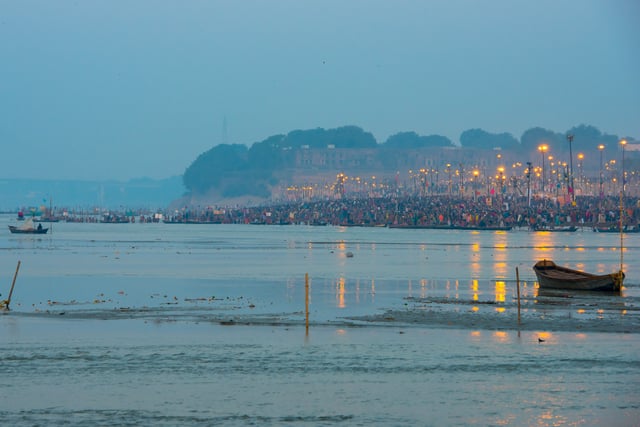
Kumbh Mela 2013 at Sangam, Allahabad
Uttar Pradesh ranks first in domestic tourist arrivals among all states of India with more than 71 million,[235][236] owing to its rich and varied topography, vibrant culture, festivals, monuments, ancient places of worship, and viharas. Uttar Pradesh is also home to three World Heritage Sites: the Taj Mahal, Agra Fort, and the nearby Fatehpur Sikri.
Millions gather at Allahabad to take part in the Magh Mela festival on the banks of the Ganges.[237] This festival is organised on a larger scale every 12th year and is called the Kumbh Mela, where over 10 million Hindu pilgrims congregate in one of the largest gatherings of people in the world.[238]
The historically important towns of Sarnath and Kushinagar are near to Gorakhpur and are located not far from Varanasi.[239] Gautama Buddha gave his first sermon after his enlightenment at Sarnath and died at Kushinagar; both are important pilgrimage sites for Buddhists. Also at Sarnath are the Pillars of Ashoka and the Lion Capital of Ashoka, both important archaeological artefacts with national significance. At a distance of 80 km from Varanasi, Ghazipur is famous not only for its Ghats on the Ganges but also for the tomb of Lord Cornwallis, the 18th-century Governor of East India Company ruled Bengal Presidency. The tomb is maintained by the Archaeological Survey of India.[240] The state also has a bird sanctuary in Etah district called Patna Bird Sanctuary.
To promote tourism, the Directorate of Tourism was established in the 1972 with a Director General who is an IAS. officer. In 1974 the Uttar Pradesh State Tourism Development Corporation was established to look after the commercial tourist activities.[243]
Healthcare
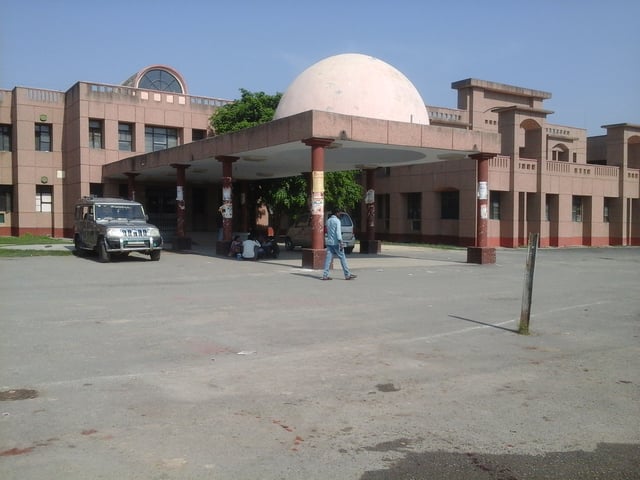
District Hospital, Kanpur Dehat
Uttar Pradesh has a large public as well as private healthcare infrastructure. Although an extensive network of public and private sector healthcare providers has been built, the available health infrastructure is inadequate to meet the demand for health services in the state.[244] In 15 years to 2012–13, the population of Uttar Pradesh increased by more than 25 percent. The public health centres, which are the frontline of the government’s health care system, decreased by 8 percent.[245] Smaller sub-centres, the first point of public contact, increased by no more than 2 per cent over the 25 years to 2015, a period when the population grew by more than 51 percent.[245]
A newborn in Uttar Pradesh is expected to live four years fewer than in the neighboring state of Bihar, five years fewer than in Haryana and seven years fewer than in Himachal Pradesh. Uttar Pradesh contributed to the largest share of almost all communicable and noncommunicable disease deaths, including 48 per cent of all typhoid deaths (2014); 17 per cent of cancer deaths and 18 per cent of tuberculosis deaths (2015).[245] After Assam, Uttar Pradesh has India’s second-highest maternal mortality rate, 285 maternal deaths for every 100,000 live births (2013), with 62 percent of pregnant women unable to access minimum ante-natal care.[245]
Around 42 per cent of pregnant women, more than 1.5 million, deliver babies at home. About two-thirds (61 per cent) of childbirths at home in Uttar Pradesh are unsafe.[246] State has the highest child mortality indicators, from the neonatal mortality rate (NNMR) to the under-five mortality rate of 64 children who die per 1,000 live births before five years of age, 35 die within a month of birth, and 50 do not complete a year of life.[247] A third of the rural population in the state has been deprived of primary healthcare infrastructure, according to the norms of the Indian Public Health Standards.[248]
Culture
Language and literature

The battle of Kurukshetra, folio from the Mahabharata
Several texts and hymns of the Vedic literature were composed in Uttar Pradesh. The festival of Guru Purnima is dedicated to Sage Vyasa, and also known as Vyasa Purnima as it is the day which is believed to be his birthday and also the day he divided the Vedas.[249] There is a long literary and folk Hindi-language tradition in the state. In the 19th and 20th century, Hindi literature was modernised by authors such as Jaishankar Prasad, Maithili Sharan Gupt, Munshi Premchand, Suryakant Tripathi Nirala, Babu Gulabrai, Sachchidananda Hirananda Vatsyayan 'Agyeya', Rahul Sankrityayan, Harivansh Rai Bachchan, Dharamvir Bharati, Subhadra Kumari Chauhan, Mahavir Prasad Dwivedi, Swami Sahajanand Saraswati, Dushyant Kumar, Hazari Prasad Dwivedi, Acharya Kuber Nath Rai, Bharatendu Harishchandra, Kamleshwar Prasad Saxena, Shivmangal Singh Suman, Mahadevi Varma, and Vibhuti Narain Rai.[250]
The state is sometimes called the 'Hindi heartland of India'.[251] Hindi became the language of state administration with the Uttar Pradesh Official Language Act of 1951. A 1989 amendment to the act added Urdu, as an additional language of the state.[252] Linguistically, the state spreads across the Central, East-Central, and Eastern zones of the Hindi Belt, the major Hindi dialects of the state being Awadhi, Bhojpuri, Bundeli, Braj Bhasha, Kannauji and the vernacular form of Khariboli.[253]
Music and dance
Uttar Pradesh has produced musicians, including Anup Jalota, Girija Devi, Kishan Maharaj[254] Naushad Ali, Ravi Shankar, Vikash Maharaj, Shubha Mudgal, Siddheshwari Devi, Talat Mehmood, and Ustad Bismillah Khan. The Ghazal singer Begum Akhtar was a native of Uttar Pradesh. The region's folk heritage includes songs called rasiya (especially popular in Braj), which celebrate the divine love of Radha and Krishna. Other forms of music are kajari, sohar, qawwali, rasiya, thumri, birha, chaiti, and sawani. Traditional dance and musical styles are taught at the Bhatkhande Music Institute University in Lucknow, named after the musician Pandit Vishnu Narayan Bhatkhande.[255]
Kathak, a classical dance form, owes its origin to the state of Uttar Pradesh.[89] The dance form is connected to classical Hindustani music where the rhythmic nimbleness of the feet is accompanied by either Tabla or Pakhawaj.[256] Four of the six schools of this dance form, Lucknow gharana, Ajrara gharana, Farukhabad gharana and Benares gharana, are situated in Uttar Pradesh.[257][258]
Fairs and festivals
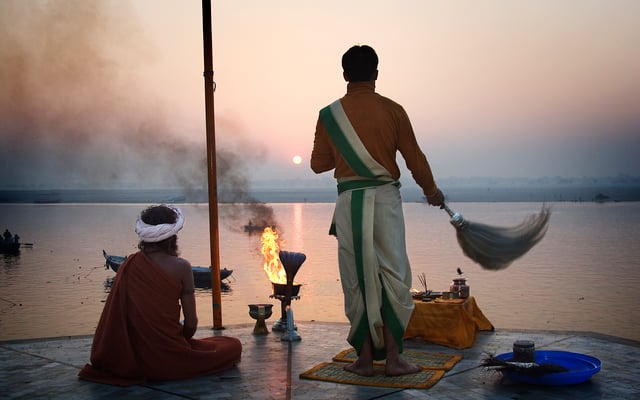
Hindu priest saluting the sun in the Ganges, Varanasi.
Diwali (celebrated between mid-October and mid-December) and Rama Navami are popular festivals in Uttar Pradesh. Kumbh Mela, organised in the month of Maagha (February—March), is a major festival held every twelve years in rotation at Allahabad, Haridwar, Ujjain, on the river Ganges and Nasik on the Godavari river.[259] Lath mar Holi is a local celebration of the Hindu festival of Holi. It takes place well before the actual Holi in the town of Barsana near Mathura. Taj Mahotsav, held annually at Agra, is a colourful display of the culture of the Braj area.[260] Buddha Purnima, which marks the birth of Gautama Buddha, is a major Hindu and Buddhist festival, while Christmas is celebrated by the minority Christian population. Other festivals are Eid-ul-Fitr, Eid-ul-Adhaa/Bakreed, Vijayadashami, Makar Sankranti, Vasant Panchami, Ayudha Puja, Ganga Mahotsava, Janmashtami, Sardhana Christian Fair, Maha Shivaratri, Mahavir Jayanti, Bārah Wafāṭ, Chhath puja, Lucknow Mahotsav, Moharram, Kabob and Hanuman Jayanti.[261]
Cuisine
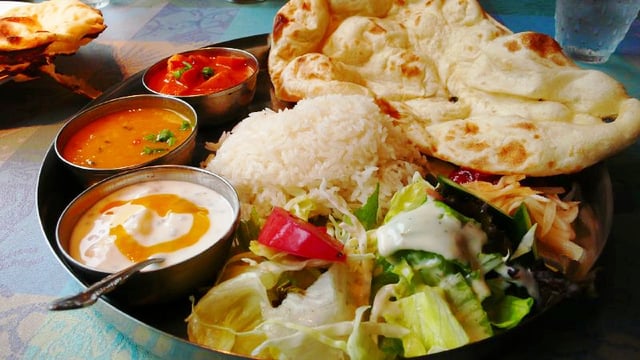
Uttar Pradeshi thali with naan, sultani dal, raita, and shahi paneer.
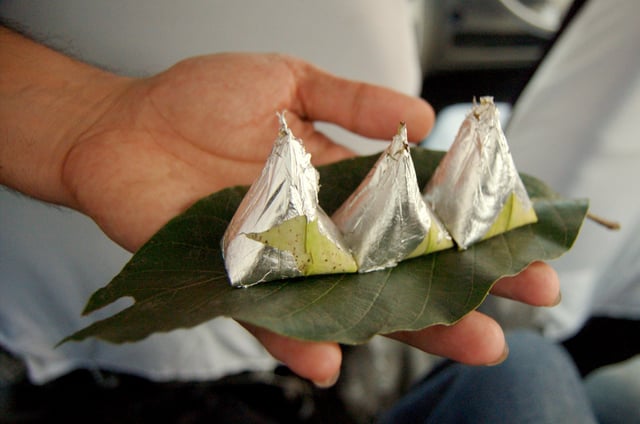
Paan, (betel leaves) being served with silver foil
A typical day-to-day traditional vegetarian meal of Uttar Pradesh, like any other North Indian thali, consists of roti (flatbread), chawal, dal, sabji, raita and papad. Many people still drink the traditional drink chaach (traditional buttermilk) with meals. On festive occasions, usually 'tava' (flat pan for roti) is considered inauspicious, and instead fried foods are consumed. A typical festive thali consists of Puri, Kachauri, sabji, pulav, papad, raita, salad and desserts (such as sewai or Kheer).
Many communities have their own particular style of cuisines, such as the Jains, Kayasths and Muslims. There are also certain sub-regional delicacies. Awadhi cuisine is world-famous for dishes such as kebab, biryani, keema and nihari. Sweets occupy an important place in the Hindu diet and are eaten at social ceremonies. People make distinctive sweetmeats from milk products, including khurchan, peda, gulabjamun, petha, makkhan malai, and chamcham. The chaat in Lucknow and Banarasi Paan is known across India for its flavour and ingredients.[262]
Awadhi cuisine is from the city of Lucknow. The cuisine consists of both vegetarian and non-vegetarian dishes. Awadh has been greatly influenced by Mughal cooking techniques, and the cuisine of Lucknow bears similarities to those of Central Asia, Kashmir, Punjab and Hyderabad; and the city is known for Nawabi foods.[263] The bawarchis and rakabdars of Awadh gave birth to the dum style of cooking or the art of cooking over a slow fire, which has become synonymous with Lucknow today. Their spread consisted of elaborate dishes like kebabs, kormas, biryani, kaliya, nahari-kulchas, zarda, sheermal, roomali rotis, and warqi parathas. The richness of Awadh cuisine lies not only in the variety of cuisine but also in the ingredients used like mutton, paneer, and rich spices including cardamom and saffron.
Mughlai cuisine is a style of cooking developed in the Indian subcontinent by the imperial kitchens of the Mughal Empire. It represents the cooking styles used in North India, especially Uttar Pradesh. The cuisine is strongly influenced by the cuisine of Central Asia, and has in turn strongly similarities to the regional cuisines of Kashmir and the Punjab region.[263] The tastes of Mughlai cuisine vary from extremely mild to spicy, and is often associated with a distinctive aroma and the taste of ground and whole spices.
Attire
The people of Uttar Pradesh dress in a variety of traditional and Western styles.[264] Traditional styles of dress include colourful draped garments—such as sari for women and dhoti or lungi for men—and tailored clothes such as salwar kameez for women and kurta-pyjama for men.[264] Men often sport head-gear like different type of caps or turbans.[264] Sherwani is a more formal male dress and is frequently worn along with chooridar on festive occasions.Western-style trousers and shirts are also common among the men.[264]
Media
A number of newspapers and periodicals are published in Hindi, English, and Urdu. The Pioneer was founded in Allahabad in 1865 by George Allen.[265] Amar Ujala, Dainik Bhaskar, Dainik Jagran, Rajasthan Patrika and Hindustan Dainik have a wide circulation, with local editions published from several important cities. Major English language newspapers which are published and sold in large numbers are The Telegraph, The Times of India, Hindustan Times, The Hindu, The Statesman, The Indian Express, and Asian Age. Some prominent financial dailies like The Economic Times, Financial Express, Business Line, and Business Standard are widely circulated. Vernacular newspapers such as those in Hindi, Nepali, Gujarati, Odia, Urdu, and Punjabi are also read by a select readership.
Doordarshan is the state-owned television broadcaster. Multi system operators provide a mix of Hindi, English, Bengali, Nepali and international channels via cable. Hindi 24-hour television news channels are NDTV India, DD News, *Zee News *, Aaj Tak, News18 India, and ABP News. All India Radio is a public radio station. There are 32 private FM stations available in major cities like Lucknow, Kanpur, Varanasi, Allahabad, Agra, and Noida.[266][267] Cell phone providers include Vodafone, Airtel, BSNL, Reliance Jio, Reliance Communications, Telenor, Aircel,Tata Indicom, Idea Cellular, and Tata DoCoMo. Broadband internet is available in select towns and cities and is provided by the state-run BSNL and by private companies.[268] Dial-up access is provided throughout the state by BSNL and other providers.[269]
See also
List of Chief Ministers of Uttar Pradesh
List of Governors of Uttar Pradesh
List of people from Uttar Pradesh
Nawabganj Bird Sanctuary
Outline of India
Social Mobilisation Network (SMNet)
